Abstract
By using a gene-specific fragment from the hemolytic phospholipase C (PLC) gene of Pseudomonas aeruginosa as a probe and data from Southern hybridizations under reduced stringency conditions, we cloned a 4.2-kb restriction fragment from a beta-hemolytic Pseudomonas cepacia strain which expressed hemolytic and PLC activities in Escherichia coli under the control of the lac promoter. It was found, by using a T7 phage promoter-directed expression system, that this DNA fragment carries at least two genes. One gene which shares significant DNA homology with both PLC genes from P. aeruginosa encodes a 72-kDa protein, while the other gene encodes a 22-kDa protein. When both genes on the 4.2-kb fragment were expressed from the T7 promoter in the same cell, hemolytic and PLC activities could be detected in the cell lysate. In contrast, when each individual gene was expressed in different cells or when lysates containing the translated products of each separate gene were mixed, neither hemolytic activity nor PLC activity could be detected. Clinical and environmental isolates of P. cepacia were examined for beta-hemolytic activity, PLC activity, sphingomyelinase activity, and reactivity in Southern hybridizations with a probe from P. cepacia which is specific for the larger gene which encodes the 72-kDa protein. There were considerable differences in the ability of the different strains to express hemolytic and PLC activities, and the results of Southern DNA-DNA hybridizations of the genomic DNAs of these strains revealed considerable differences in the probe-reactive fragments between high- and medium-stringency conditions as well as remarkable variation in size and number of probe-reactive fragments among different strains. Analysis of the genomic DNAs from hemolytic and nonhemolytic variants of an individual strain (PC-69) by agarose gel electrophoresis. Southern hybridization, and transverse alternating pulsed field gel electrophoresis suggests that the conversion of the hemolytic phenotype to the nonhemolytic phenotype is associated with either the loss of a large plasmid (greater than 200 kb) or a large deletion of the chromosome of P. cepacia PC-69.
Full text
PDF



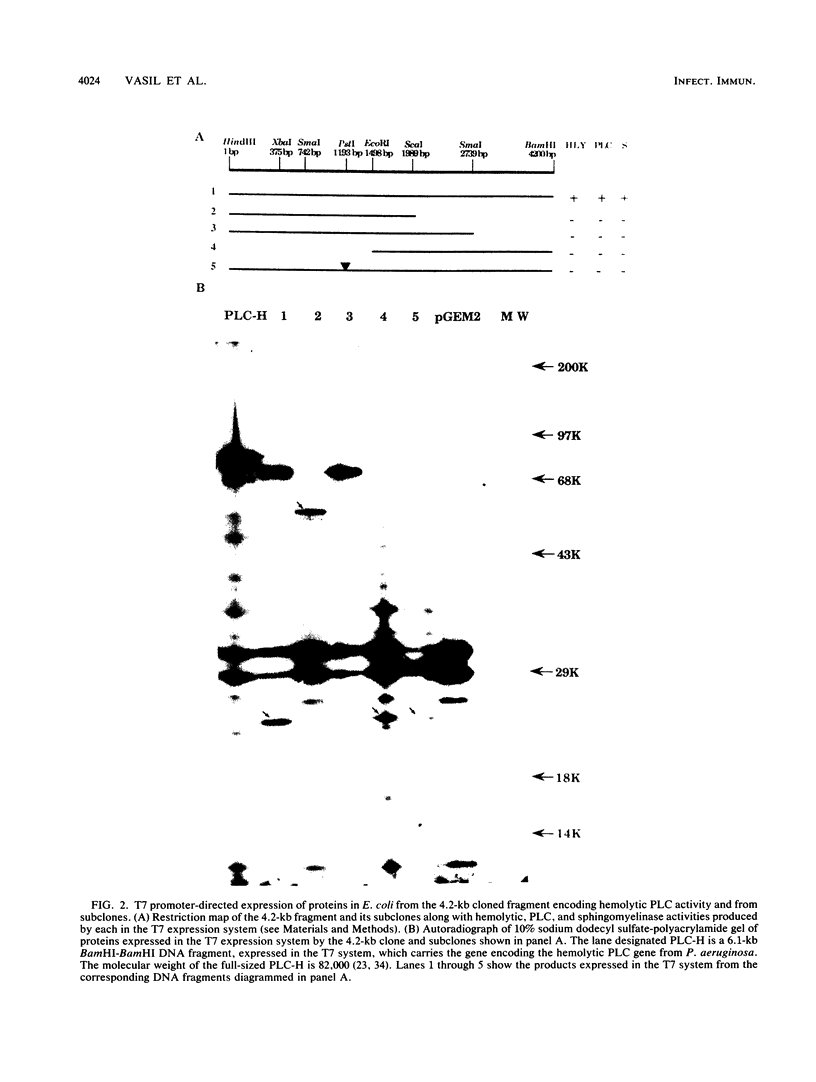
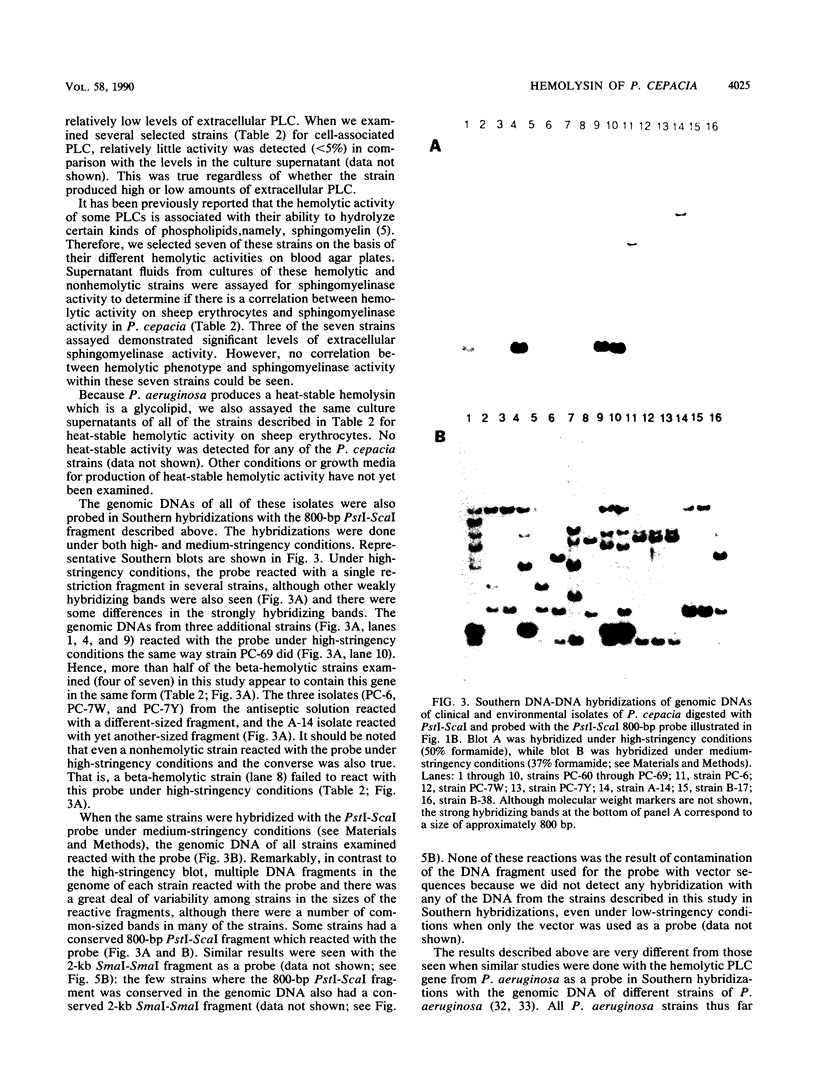
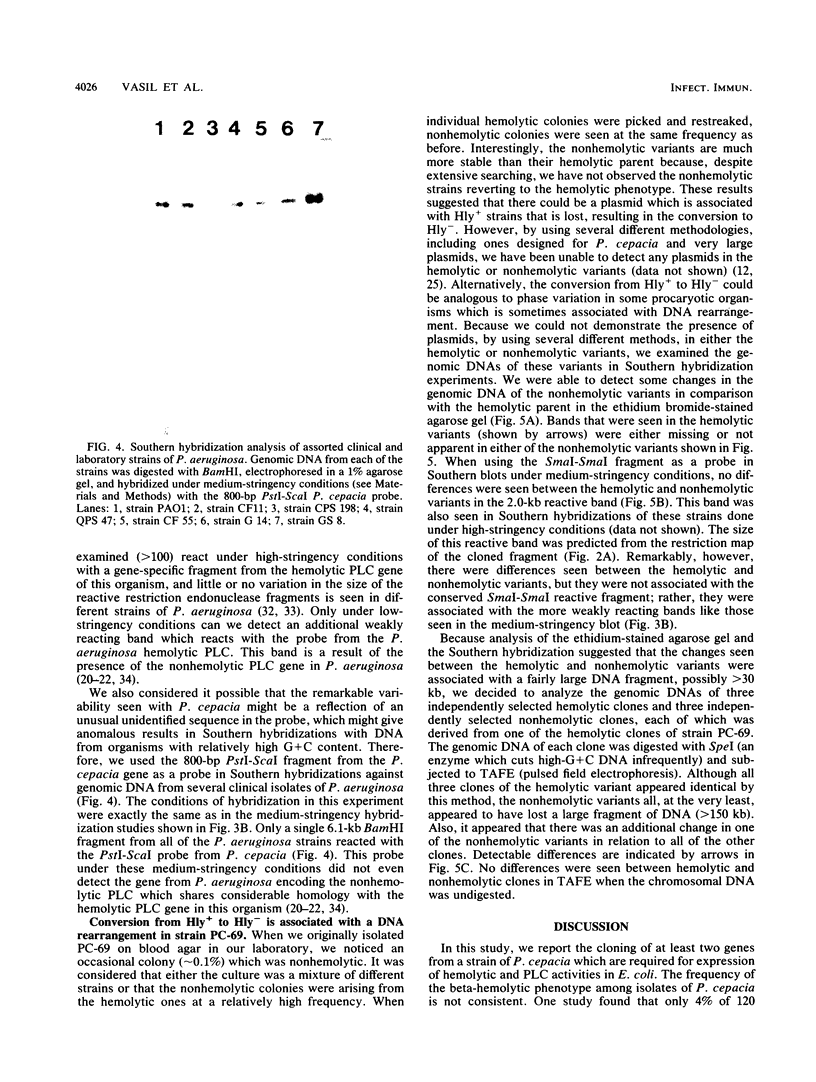

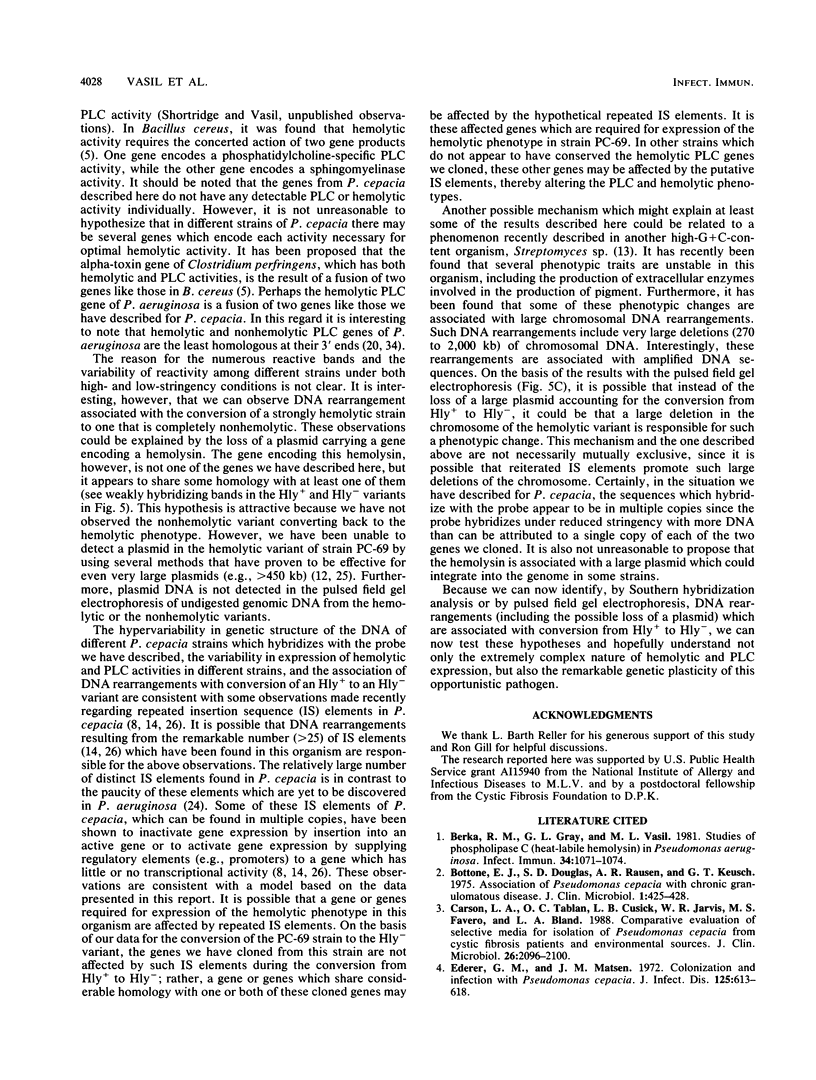
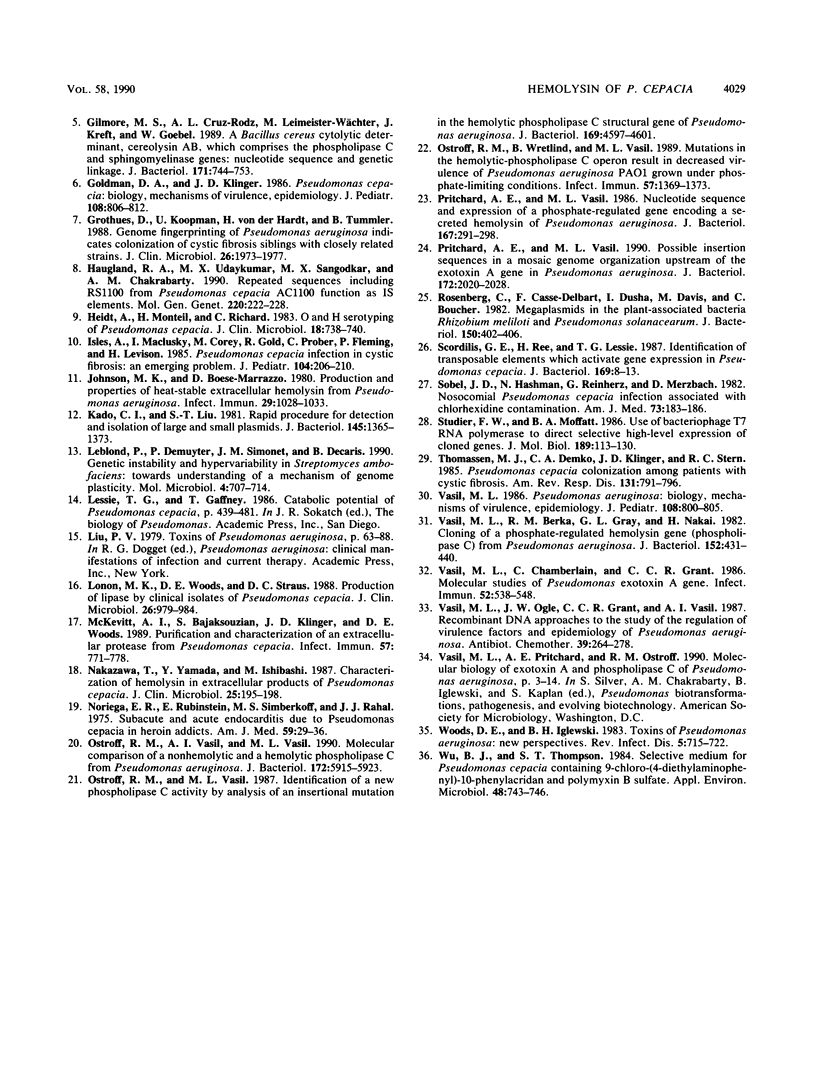
Images in this article
Selected References
These references are in PubMed. This may not be the complete list of references from this article.
- Berka R. M., Gray G. L., Vasil M. L. Studies of phospholipase C (heat-labile hemolysin) in Pseudomonas aeruginosa. Infect Immun. 1981 Dec;34(3):1071–1074. doi: 10.1128/iai.34.3.1071-1074.1981. [DOI] [PMC free article] [PubMed] [Google Scholar]
- Bottone E. J., Douglas S. D., Rausen A. R., Keusch G. T. Association of Pseudomonas cepacia with chronic granulomatous disease. J Clin Microbiol. 1975 May;1(5):425–428. doi: 10.1128/jcm.1.5.425-428.1975. [DOI] [PMC free article] [PubMed] [Google Scholar]
- Carson L. A., Tablan O. C., Cusick L. B., Jarvis W. R., Favero M. S., Bland L. A. Comparative evaluation of selective media for isolation of Pseudomonas cepacia from cystic fibrosis patients and environmental sources. J Clin Microbiol. 1988 Oct;26(10):2096–2100. doi: 10.1128/jcm.26.10.2096-2100.1988. [DOI] [PMC free article] [PubMed] [Google Scholar]
- Ederer G. M., Matsen J. M. Colonization and infection with Pseudomonas cepacia. J Infect Dis. 1972 Jun;125(6):613–618. doi: 10.1093/infdis/125.6.613. [DOI] [PubMed] [Google Scholar]
- Gilmore M. S., Cruz-Rodz A. L., Leimeister-Wächter M., Kreft J., Goebel W. A Bacillus cereus cytolytic determinant, cereolysin AB, which comprises the phospholipase C and sphingomyelinase genes: nucleotide sequence and genetic linkage. J Bacteriol. 1989 Feb;171(2):744–753. doi: 10.1128/jb.171.2.744-753.1989. [DOI] [PMC free article] [PubMed] [Google Scholar]
- Goldmann D. A., Klinger J. D. Pseudomonas cepacia: biology, mechanisms of virulence, epidemiology. J Pediatr. 1986 May;108(5 Pt 2):806–812. doi: 10.1016/s0022-3476(86)80749-1. [DOI] [PubMed] [Google Scholar]
- Grothues D., Koopmann U., von der Hardt H., Tümmler B. Genome fingerprinting of Pseudomonas aeruginosa indicates colonization of cystic fibrosis siblings with closely related strains. J Clin Microbiol. 1988 Oct;26(10):1973–1977. doi: 10.1128/jcm.26.10.1973-1977.1988. [DOI] [PMC free article] [PubMed] [Google Scholar]
- Haugland R. A., Sangodkar U. M., Chakrabarty A. M. Repeated sequences including RS1100 from Pseudomonas cepacia AC1100 function as IS elements. Mol Gen Genet. 1990 Jan;220(2):222–228. doi: 10.1007/BF00260485. [DOI] [PubMed] [Google Scholar]
- Heidt A., Monteil H., Richard C. O and H serotyping of Pseudomonas cepacia. J Clin Microbiol. 1983 Sep;18(3):738–740. doi: 10.1128/jcm.18.3.738-740.1983. [DOI] [PMC free article] [PubMed] [Google Scholar]
- Isles A., Maclusky I., Corey M., Gold R., Prober C., Fleming P., Levison H. Pseudomonas cepacia infection in cystic fibrosis: an emerging problem. J Pediatr. 1984 Feb;104(2):206–210. doi: 10.1016/s0022-3476(84)80993-2. [DOI] [PubMed] [Google Scholar]
- Johnson M. K., Boese-Marrazzo D. Production and properties of heat-stable extracellular hemolysin from Pseudomonas aeruginosa. Infect Immun. 1980 Sep;29(3):1028–1033. doi: 10.1128/iai.29.3.1028-1033.1980. [DOI] [PMC free article] [PubMed] [Google Scholar]
- Kado C. I., Liu S. T. Rapid procedure for detection and isolation of large and small plasmids. J Bacteriol. 1981 Mar;145(3):1365–1373. doi: 10.1128/jb.145.3.1365-1373.1981. [DOI] [PMC free article] [PubMed] [Google Scholar]
- Leblond P., Demuyter P., Simonet J. M., Decaris B. Genetic instability and hypervariability in Streptomyces ambofaciens: towards an understanding of a mechanism of genome plasticity. Mol Microbiol. 1990 May;4(5):707–714. doi: 10.1111/j.1365-2958.1990.tb00641.x. [DOI] [PubMed] [Google Scholar]
- Lonon M. K., Woods D. E., Straus D. C. Production of lipase by clinical isolates of Pseudomonas cepacia. J Clin Microbiol. 1988 May;26(5):979–984. doi: 10.1128/jcm.26.5.979-984.1988. [DOI] [PMC free article] [PubMed] [Google Scholar]
- McKevitt A. I., Bajaksouzian S., Klinger J. D., Woods D. E. Purification and characterization of an extracellular protease from Pseudomonas cepacia. Infect Immun. 1989 Mar;57(3):771–778. doi: 10.1128/iai.57.3.771-778.1989. [DOI] [PMC free article] [PubMed] [Google Scholar]
- Nakazawa T., Yamada Y., Ishibashi M. Characterization of hemolysin in extracellular products of Pseudomonas cepacia. J Clin Microbiol. 1987 Feb;25(2):195–198. doi: 10.1128/jcm.25.2.195-198.1987. [DOI] [PMC free article] [PubMed] [Google Scholar]
- Noriega E. R., Rubinstein E., Simberkoff M. S., Rahal J. J. Subacute and acute endocarditis due to Pseudomonas cepacia in heroin addicts. Am J Med. 1975 Jul;59(1):29–36. doi: 10.1016/0002-9343(75)90318-6. [DOI] [PubMed] [Google Scholar]
- Ostroff R. M., Vasil A. I., Vasil M. L. Molecular comparison of a nonhemolytic and a hemolytic phospholipase C from Pseudomonas aeruginosa. J Bacteriol. 1990 Oct;172(10):5915–5923. doi: 10.1128/jb.172.10.5915-5923.1990. [DOI] [PMC free article] [PubMed] [Google Scholar]
- Ostroff R. M., Vasil M. L. Identification of a new phospholipase C activity by analysis of an insertional mutation in the hemolytic phospholipase C structural gene of Pseudomonas aeruginosa. J Bacteriol. 1987 Oct;169(10):4597–4601. doi: 10.1128/jb.169.10.4597-4601.1987. [DOI] [PMC free article] [PubMed] [Google Scholar]
- Ostroff R. M., Wretlind B., Vasil M. L. Mutations in the hemolytic-phospholipase C operon result in decreased virulence of Pseudomonas aeruginosa PAO1 grown under phosphate-limiting conditions. Infect Immun. 1989 May;57(5):1369–1373. doi: 10.1128/iai.57.5.1369-1373.1989. [DOI] [PMC free article] [PubMed] [Google Scholar]
- Pritchard A. E., Vasil M. L. Nucleotide sequence and expression of a phosphate-regulated gene encoding a secreted hemolysin of Pseudomonas aeruginosa. J Bacteriol. 1986 Jul;167(1):291–298. doi: 10.1128/jb.167.1.291-298.1986. [DOI] [PMC free article] [PubMed] [Google Scholar]
- Pritchard A. E., Vasil M. L. Possible insertion sequences in a mosaic genome organization upstream of the exotoxin A gene in Pseudomonas aeruginosa. J Bacteriol. 1990 Apr;172(4):2020–2028. doi: 10.1128/jb.172.4.2020-2028.1990. [DOI] [PMC free article] [PubMed] [Google Scholar]
- Rosenberg C., Casse-Delbart F., Dusha I., David M., Boucher C. Megaplasmids in the plant-associated bacteria Rhizobium meliloti and Pseudomonas solanacearum. J Bacteriol. 1982 Apr;150(1):402–406. doi: 10.1128/jb.150.1.402-406.1982. [DOI] [PMC free article] [PubMed] [Google Scholar]
- Scordilis G. E., Ree H., Lessie T. G. Identification of transposable elements which activate gene expression in Pseudomonas cepacia. J Bacteriol. 1987 Jan;169(1):8–13. doi: 10.1128/jb.169.1.8-13.1987. [DOI] [PMC free article] [PubMed] [Google Scholar]
- Sobel J. D., Hashman N., Reinherz G., Merzbach D. Nosocomial Pseudomonas cepacia infection associated with chlorhexidine contamination. Am J Med. 1982 Aug;73(2):183–186. doi: 10.1016/0002-9343(82)90176-0. [DOI] [PubMed] [Google Scholar]
- Studier F. W., Moffatt B. A. Use of bacteriophage T7 RNA polymerase to direct selective high-level expression of cloned genes. J Mol Biol. 1986 May 5;189(1):113–130. doi: 10.1016/0022-2836(86)90385-2. [DOI] [PubMed] [Google Scholar]
- Thomassen M. J., Demko C. A., Klinger J. D., Stern R. C. Pseudomonas cepacia colonization among patients with cystic fibrosis. A new opportunist. Am Rev Respir Dis. 1985 May;131(5):791–796. doi: 10.1164/arrd.1985.131.5.791. [DOI] [PubMed] [Google Scholar]
- Vasil M. L., Berka R. M., Gray G. L., Nakai H. Cloning of a phosphate-regulated hemolysin gene (phospholipase C) from Pseudomonas aeruginosa. J Bacteriol. 1982 Oct;152(1):431–440. doi: 10.1128/jb.152.1.431-440.1982. [DOI] [PMC free article] [PubMed] [Google Scholar]
- Vasil M. L., Chamberlain C., Grant C. C. Molecular studies of Pseudomonas exotoxin A gene. Infect Immun. 1986 May;52(2):538–548. doi: 10.1128/iai.52.2.538-548.1986. [DOI] [PMC free article] [PubMed] [Google Scholar]
- Vasil M. L., Ogle J. W., Grant C. C., Vasil A. I. Recombinant DNA approaches to the study of the regulation of virulence factors and epidemiology of Pseudomonas aeruginosa. Antibiot Chemother (1971) 1987;39:264–278. doi: 10.1159/000414352. [DOI] [PubMed] [Google Scholar]
- Vasil M. L. Pseudomonas aeruginosa: biology, mechanisms of virulence, epidemiology. J Pediatr. 1986 May;108(5 Pt 2):800–805. doi: 10.1016/s0022-3476(86)80748-x. [DOI] [PubMed] [Google Scholar]
- Wu B. J., Thompson S. T. Selective medium for Pseudomonas cepacia containing 9-chloro-9-(4-diethylaminophenyl)-10-phenylacridan and polymyxin B sulfate. Appl Environ Microbiol. 1984 Oct;48(4):743–746. doi: 10.1128/aem.48.4.743-746.1984. [DOI] [PMC free article] [PubMed] [Google Scholar]






